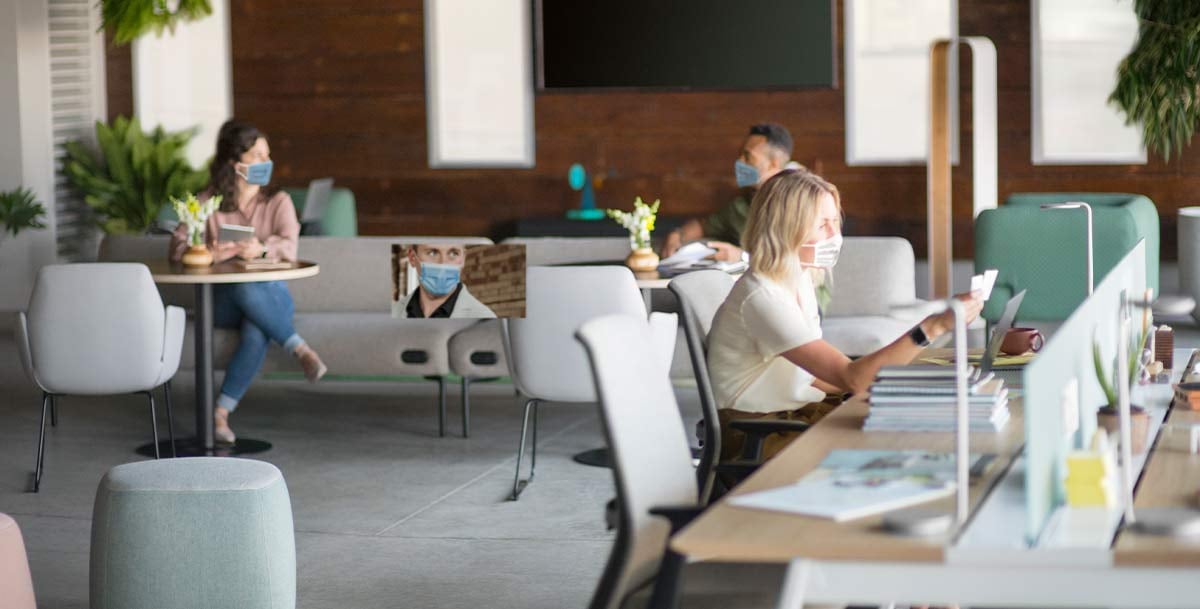
When we think back to the first half of 2020, it was hard to imagine how entrenched we would be in remote work today, or how much impact blending remote work with office work would have on us. The COVID-19 pandemic has dramatically changed the way we work, interact, and communicate within an organization. It is also forcing us to take a critical look at the way we use our physical spaces as we transition back into the workplace.
As we’ve adapted to this new paradigm, we’ve seen the rise of the hybrid workplace. With a hybrid model, employees can opt to work either from home or from the office, depending on the specific demands of their job. A hybrid workplace allows for flexible scheduling, which supports employee wellness and environmental sustainability. Headquarters are shifting into collaboration and gathering hubs. With headquarters shifting their functionality, meetings and collaborative work can be done safely in-person and employees have access to a dedicated workspace when they need it.
While many employees strive for some type of permanent flexibility between going into the office and working remotely, the hybrid office as a concept has some inherent issues, particularly with maintaining productivity and positive company culture.
“The importance of the employee experience cannot be underestimated and it’s going to be a lot more challenging as we continue with remote work. The employee experience is one of the most important factors in what drives your company culture and productivity, and what attracts and retains your best employees.”
Jim Kastner, CEO, Unisource Solutions
Even with these hurdles, the hybrid office is here to stay–at least for the foreseeable future. The challenge that most businesses face is how to optimize and manage this transition. To communicate a clear path forward for your team, you need to identify and execute a transformational management strategy for your workplace.
How are companies transitioning to hybrid work?
Every company needs their own unique approach to hybrid work. One size does not fit all when it comes to hybrid working. We’re seeing companies requiring employees to be in the office on specific days, while others are letting them choose which days to come in. Most companies are requiring employees to reserve desks and meeting rooms in advance.
Safety and work protocols continue to change in an unpredictable manner, which even further underscores the importance of planning for and managing workplace transformation.
Hybrid Workplace Management: See workplace transformation services »
Tech companies have been some of the first to put hybrid plans in place for the future. In July 2021, Facebook had returned at 10% capacity and was working to fully re-open by October, but with changing mandates, is working on managing new expectations. In this same fluid environment, Google expects about 20% of its workforce to remain fully remote by this fall, while 60% will work a hybrid home/office mix.
Apple recently asked their employees to come into the office three days per week by September. Many employees were unhappy with this option. Since the policy was announced, some employees quit, and others have written a letter to CEO Tim Cook asking for more flexibility. In the last few weeks, they’ve since postponed their return to office by a month to respond to the more aggressive Delta variant of COVID-19. The way companies communicate to their employees and strategize for the future is of the utmost importance right now.
The finance industry is taking a different approach. The CEOs of Morgan Stanley and Bank of America have both indicated that they need their teams back in the office this fall. However, they are still providing some flexibility for working parents. With so many employees heading back into the office in the next few months, which businesses are succeeding and what can we learn from them? We can look at current office trends to develop the best possible solutions for your workplace?

How can my company transition effectively to a hybrid work model?
Many companies are at a crossroads right now. There are certain elements of the workplace that cannot be replicated at home.
For many companies, a hybrid office model is the best way to keep employees happy while remaining productive. When competitive edge matters more than ever, is separating and isolating your team the best option? How are you communicating your culture, your brand, and your workflow to remain efficient as you transition to a more permanently hybrid model?
How do you transition from the pre-COVID office model to a modern, hybrid one? Working with a trusted expert is the best way to build the right hybrid workspace for your team. Our workspace optimization services are designed to help you create a comfortable, healthy, and productive office using our 30+ years of experience in partnering with some of the most high-performing firms in the country.
At Unisource Solutions, we use a data-driven workplace optimization process to build a space that works for your team. We know for sure that hybrid work is the future - here are some of the trends, challenges, and solutions we’re seeing in 2021 as companies transition to remote work.

1. Communication Is Key for Employee Engagement
Employees are typically at their most productive when they feel supported by company leadership. A comfortable and efficient workspace is going to look different for everyone - some people do well in an isolated environment, while others thrive on interaction and stimulation. This is why it’s so important to communicate closely with your team while you transition to a hybrid work model.
Our team can help you create an environment that facilitates communication and put together a strategic plan to help you get there.
A dedicated focus on employee engagement is very important for any hybrid work model. Having a fully engaged team can increase profitability and productivity dramatically. Conducting regular check-ins and reducing distractions can go a long way towards keeping your employees engaged at work.
2. Safety Is Still A Concern
A large percentage of workers in the US are already vaccinated for COVID-19, but safety concerns remain as variants spread across the world. Your office should be set up with these safety concerns in mind, and there are many small changes you can make to help your employees feel more comfortable. These include socially distant seating, hand sanitizer stations, and reliable ventilation.
3. Smart Technology Is Evolving
Installing smart technology in your office can have benefits for both your bottom line and employee satisfaction. One popular example of smart technology in the office is occupancy sensors. These sensors determine where people are in the office and adjust lights, heat, or air conditioning accordingly. With a hybrid workplace model, the office won’t be full all the time, and smart technology ensures that you are only using the resources you need.
4. Offices Should Feel Collaborative
The last year has proven that many individual work tasks can be done comfortably from home. This means that the office will likely transition into a more social and hospitable space. Your new hybrid office should be designed with collaboration and comfort in mind. Meeting rooms and open office layouts are going to be more valuable than cubicles. Amenities like food and beverage, entertainment and recreation, will support employees who travel in from all over the country to headquarters. You’ll want to make sure you have the appropriate technology for remote and in person meetings - large screens, high-quality video cameras, headphones, and microphones. As you reduce your footprint, the goal is to make it more attractive and better for people to come back to the office. While they may not return in the same numbers, the demand for space within the office should continue to rise with your employee experience.
While there are challenges to maintaining a hybrid workplace, it’s a model that should ultimately benefit both your company and your employees. We’re excited to see where it takes us and what comes in this modern era. Contact Unisource Solutions today to learn more about how we can help you build an optimized hybrid office and manage the transition for your team.
Contact us to learn more about how we can help you manage your workplace transformation







